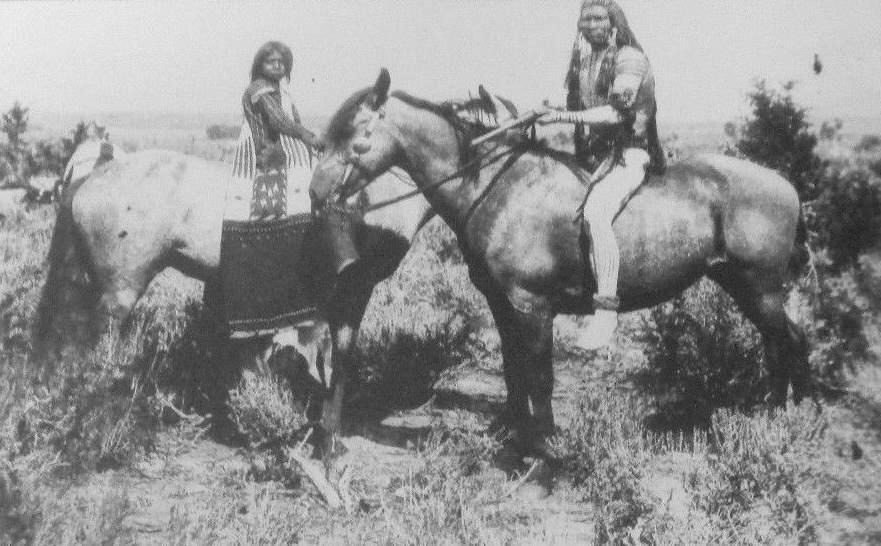
Native American Tribes: The Ute

Figure 1.--This portarit shows a Ute Warrior and a boy presumably his son in 1871. The lives of the Planrs and Great Basin tribes were transformed by the horse after wild populations became established following the arival of the Spanish. This photograph may have been taken by Cornelius David Krieghoff (1815-72) who specialized in painting Native American peoples and scenes.
|
|
The Ute were one of the importan tibes of the Plateau / Great Basin cultural area. They were a huntergather people, migrating through what is now Colorado, Utah, New Mexico, and Nevada.
The Spanish were the first Europeans to contact the Ute, but not in a major way. Spanis control of the lands of the Louisana Purchase were very limited. It is believed that he tribes modern name came from the Spanish 'Yuta' which is similar tgo the pronoubcuation of Ute (rhymes with boot.) It is not clear where the Spanish name originated, it is thought that it is the Spanish the tribe's in their own language--Nuutsiu. This meants was often the case--'the people'. The Western Apaches called them the 'yudah', meaning 'high up'.
The original homeland of the Uto-Aztecan language speakers is thought to be the borderlands between the United States and Mexico, the southeastern United States (Arizona and New Mexico) anf northwestern Mexico (Chihuahua and Sonora). Bands from this area migrated both south and north. This appears to habe been the origins of the Aztec Civilization. Bands that migrated north and transitioned into the Comanche, Soshone/Snake, and Ute. Unlike many other tribal groups in Southwest and Great Basin, the Utes have no folk tradition of historic migration or lifebefore that migration. There are of course traditional legends and what might be called fairy tales. Storytelling is an important to aspect of the Ute culture as is the case in all Native American cultures. There is, however, no migration origin tradition.
Prior to the the Spanish conquest of Mexico (16th century), the Ute people appeared to have lived in what is now western Utah and Colorado, including the San Luis Valley as well as parts of New Mexico and Wyoming. The ancestors of the Ute seem to have inhabited this area for about thousand years, perhaps longer. The Spanish intriduced horses into the New World. Escaping animals led to wild populations on the Great Planes and Great Basin which transformed the lives of the tribes like the Ute living there.
The Ute people were never a united tribal group. They were a group of small tribal bands with cultural and linguistic afinities that maintained associations with each other. Some of the groups were influenced by varying degrees to ther tribal peoples. The most important Ute tribes were the Capote, Cumumba, Moache, Moanumts, Pah Vant, Parianuche, San Pitch, Sheberetch, Taviwach, Timanogots, Tumpanawach, Uinta, Uncompahgre, White River, Weeminuche, and Yamperika.
The Ute people today are are organized into three tribal groups. Each of these tibes have their own separate reservation. Each Ute reservatiins has its own government, laws, police, and services. Traditionally chiefs governed Ute bands chosen by a tribal council. The modern approach is government by tribal councils elected by all the population of each reservation. The Ute language has almost entirely disappeared today. Young people mostly speak English. The Utes traded with neighboring tribes, including the the Navajo, Comanche, and Pueblo tribes and at times were at war with them. The Coamnche in particular often fought neighboring tribes like the Ute. Tribal alliances were transitory based on the immeduate circumstance. There were no pernaent ribal alliances. The Americans who first contacted the Ute found this hard to understand.
HBC

Navigate the Boys' Historical Clothing Web Site:
[About Us]
[Introduction]
[Activities]
[Biographies]
[Chronology]
[Clothing styles]
[Countries]
[Bibliographies]
[Contributions]
[FAQs]
[Glossaries]
[Images]
[Links]
[Registration]
[Tools]
[Boys' Clothing Home]
Navigate the Boys' Historical Clothing ethnic pages:
[Return to the Main Plateau/Great Basin cultural area page]
[Return to the Main Native American ethnic page]
[Return to the Main tribal page]
[Return to the Main ethnic page]
[German]
[Greek]
[Irish]
[Scottish]
Navigate the Boys' Historical Clothing Native American pages:
[Ethnic]
[Dance]
Created: 9:25 AM 3/26/2015
Last updated: 9:25 AM 3/26/2015



